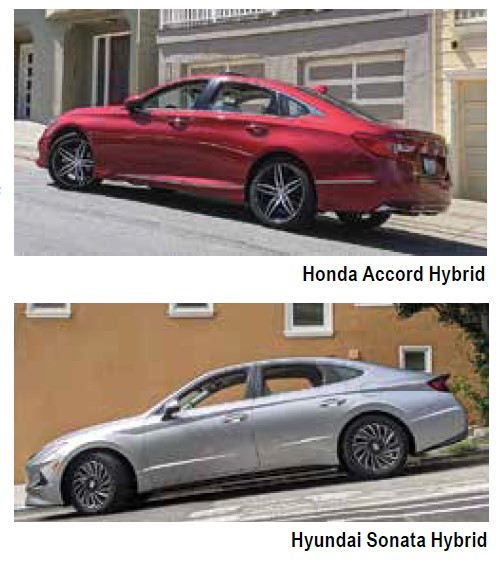
By Philip Ruth–
Hybrids keep getting better, and they’re no longer just the goofy-looking hatchbacks they once were. The newest Camry Hybrid was a revelation of speedy acceleration and enthusiastic handling, and the two competing sedans we’re examining this week—the hybrid versions of the Honda Accord and Hyundai Sonata—are impressive in their own ways.
These Honda and Hyundai hybrids are the top of their lines, and they’re priced within a gnat’s eyelash of each other. Base models see the Sonata Hybrid (uniquely named Blue) notch $1,180 higher than the Accord Hybrid, while the Honda’s top Touring trim is $1,140 more expensive than the Hyundai’s Limited guise.
Clearly these companies had one steady eye on the other as they planned these models, and not just with price. Overall EPA mileage is about the same, with the Honda’s 48 mpg beating the Hyundai’s by one. A greater difference is the extra 20 horsepower Honda pulls from its 2.0-liter, four-cylinder engine, even though they have the same number of liters.

Styling shows probably the greatest difference between them. The Honda’s fastback silhouette seemed striking when it debuted for 2018, and it still looks dramatic. The Hyundai’s design is more recent, and it is a clean break from Sonatas of the past. Its sharply angled contours are like those of no other brand, and they foreshadow the exciting Ioniq 5, the electric SUV coming this fall.
They’re also distinct in the driving. Honda employs a continuously-variable transmission (CVT), and it’s a decent version of this technology, which in some brands can produce a ballooning effect when accelerating, where the engine seems to rev faster than the car is moving. San Francisco’s hills emphasize that feeling, usually accompanied by an unrefined roar under the hood. but not so much with this Accord Hybrid’s powertrain. For the most part, it felt almost as crisp as a geared transmission.
The Hyundai’s thrust delivery was more satisfying because it actually does work with gears, six of them total, rather than a large flexible band. It goes a long way toward making the Sonata Hybrid feel like a traditional gas car, and it minimizes the electric-on-and-off lag that’s part of the hybrid experience.
They both handle well, with a bit more sportiness coloring the Honda’s comportment. The Accord Hybrid’s steering is a little sharper, and there is a touch more of a refined feel in the way it handles bumps and curves. The Sonata Hybrid lacks that extra edge of handling flair, but it’s still easy to flick around, especially considering its mid-sized dimensions.
Inside, the Honda and Hyundai are very accommodating, like full-sized versions of themselves. The front doors open wide, and the Hyundai felt brighter and airier than Honda, probably partly because of the former’s light-grey trim, as opposed to the latter’s all-black setup, the only offering on the Touring.
Both of these efficient mid-sizers should be on any hybrid buyer’s list. It’s a tossup, as each has their own emphases of engineering and design.
Philip Ruth is a Castro-based automotive photojournalist and consultant with an automotive staging service.
Published on August 12, 2021
Recent Comments